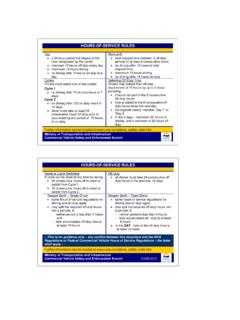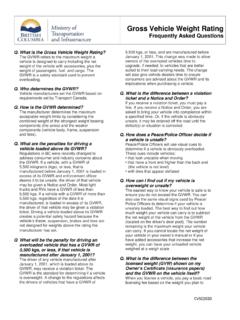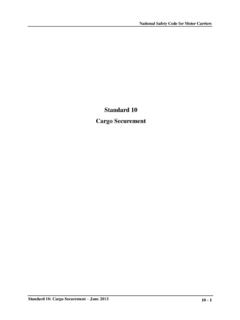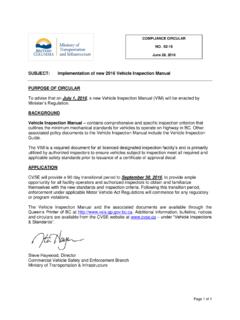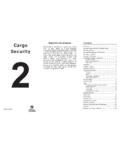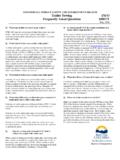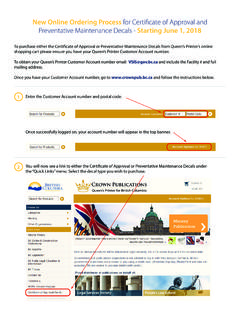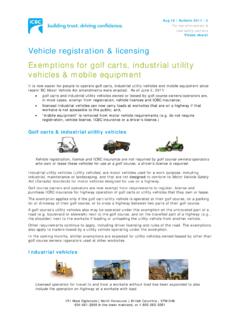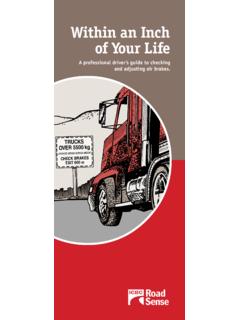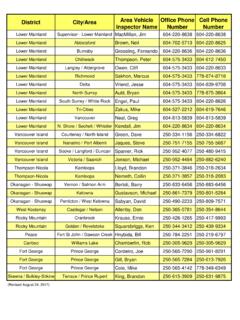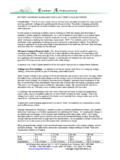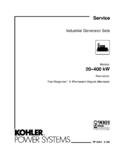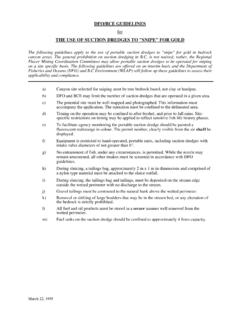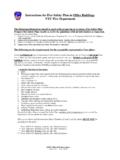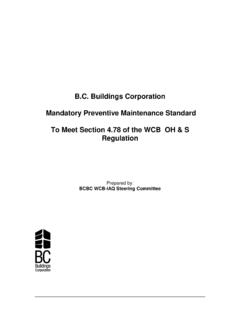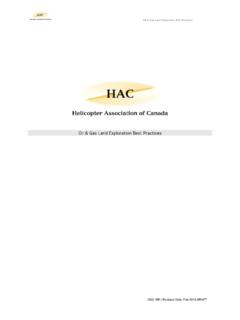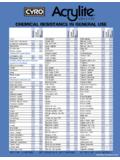Transcription of NATIONAL SAFETY CODE - British Columbia Commercial …
1 NATIONAL SAFETY code SAFETY PLAN guidelines NATIONAL SAFETY code INTRODUCTION Section (1)(d) of the Motor Vehicle Act Regulations (MVAR) requires carriers to maintain a SAFETY plan and scheduled vehicle maintenance plan applicable to the carrier. A SAFETY plan is required whether you are a small carrier with one vehicle or a carrier with a large fleet. The SAFETY plan should include all the SAFETY practices you use in your business. A good plan will help you meet your legal obligations and run a safe business. Your drivers, dispatchers, etc. need to receive a copy of your SAFETY plan.
2 This will help both you and your drivers meet the SAFETY standards you put in place. What should be included in a SAFETY plan? At minimum, your SAFETY plan should include: Company Policy Hiring policy for drivers Monitoring process for driver performance Monitoring process for hours of service Monitoring process for trip inspection Monitoring process for vehicle maintenance Monitoring process for dangerous goods (if applicable) Employee signature and date in agreement with the policy Driver Policy Driver licensing Obtaining driver abstracts (N print)
3 At least every 12 months Handing in violation tickets, Notice and Orders, roadside inspections and accident reports Hours of service Disciplinary policy Driver signature and date in agreement with the policy Vehicle Maintenance Schedule of maintenance Check sheets for each schedule Trip inspection report Dangerous Goods/Required Certificates Defensive driver training certificates First aid training certificate Certificates of Training for Dangerous Goods NATIONAL SAFETY code SAFETY PLAN guidelines NATIONAL SAFETY code DRIVERS Your SAFETY plans should include instructions to your
4 Drivers with regards to the following: Submission of accident reports, notice and orders, CVSA roadside inspections and violation tickets within 15 days of receipt Obtaining driver abstract N prints at least every 12 months. Driver abstract N print request forms can be obtained at You should have a file for each driver that at a minimum contains the following: Copies of current driver abstracts for each driver employed or otherwise engaged (MVAR (1)(a)) Accident, violation and conviction reports received from drivers within 15 days of incident (MVAR (1)(b)(ii)) Maintain records of driver abstracts, accident violation and conviction reports for the year they were created and the following 4 calendar years (MVAR ) Recommendations The carrier should.
5 Verify information submitted on employment applications prior to hiring a driver Request a copy of a driver abstract as part of the application process and establish a policy of acceptance when reviewing the abstract Establish a procedure to identify those personnel requiring further training Retain a record of all training programs provided to drivers and identify the person(s) responsible for training Develop a recall system to ensure the following remain current: Drivers licenses Drivers records of violations (abstract) Drivers dangerous goods training certificates (valid for 3 years from date of issue) Review all driver abstracts to ensure correct class.
6 Restrictions and validity of licence Develop review procedures for a driver who has a poor driving record or has been involved in a preventable accident Develop a progressive disciplinary policy for your drivers that may include: Verbal warning (documented) with expectation letter Written warning, with training Written warning with 3 day suspension Written warning with longer suspension up to and including termination Serious infractions (theft/drugs/alcohol) immediate dismissal NATIONAL SAFETY code SAFETY PLAN guidelines NATIONAL SAFETY code HOURS OF SERVICE The hours of service regulations apply to all drivers operating Commercial vehicles unless operating under MVAR or driving a truck or truck tractor with a GVW less than 11,795 kg.
7 As this weight threshold is a provincial rule it does not apply to vehicles operating outside the province. As the carrier, you are responsible to ensure that your drivers, dispatchers and other applicable employees, have the required knowledge and ability to maintain daily logs in accordance with the legislation (MVAR & ) receive adequate training to complete the daily driver graph grid log accurately (MVAR ) Your SAFETY plan should include the hours of service rules that are applicable to your operation. This should include samples and instructions of the type of documents that the driver is expected to complete, the cycle you want the driver to operate under, policies about deferral and personal use.
8 Record Keeping Daily Logs and Supporting Documents Your SAFETY plans should include a description of how you are going to maintain your daily logs and at minimum, include the following: instructions to your drivers to submit the original daily logs and supporting documents within 20 days (MVAR (1)) description of who, how and when the daily logs are going to be reviewed and monitored to ensure compliance the disciplinary action that will be taken if the drivers are non-compliant that daily logs and supporting documents will be filed within 30 days of receipt (MVAR (3)(a)) the daily logs and support documents will be retained for at least 6 months (MVAR (3)(b))
9 Record Keeping Local Drivers If you or your drivers meet the conditions to not complete daily logs, your SAFETY plan should describe the following: carrier maintains accurate and legible records for each day that includes: name of driver time at which each duty status starts and ends state driving and on-duty time separately indicate cycle being used keep the records for a minimum of 6 months NATIONAL SAFETY code SAFETY PLAN guidelines NATIONAL SAFETY code VEHICLES As a carrier, you are responsible for all vehicles that operate under your NSC SAFETY Certificate, including lease operators.
10 This includes the maintenance and use of the vehicles and any vehicles towed as part of your carrier business. Your SAFETY plans should include instructions to your drivers with regards to the following: retain a copy of current Commercial Vehicle Inspection Report in vehicle (MVAR (4)) retain copy of current trip inspection report (MVAR (5)) submit copies of CVSA inspections within 15 days (MVAR (2)) submit trip inspection reports within 20 days (MVAR ) identify defects on trip inspection report (MVAR (a)) Set up a file for each vehicle that should contain the following.
